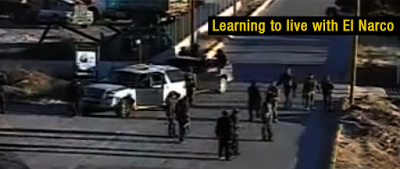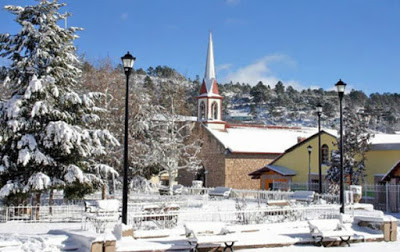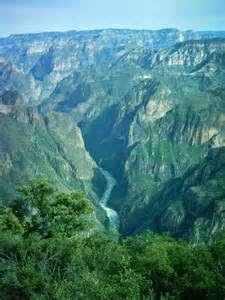| Online: | |
| Visits: | |
| Stories: |

| Story Views | |
| Now: | |
| Last Hour: | |
| Last 24 Hours: | |
| Total: | |
Life in a Pueblo Mágico that is controlled by El Narco
Saturday, December 12, 2015 23:45
% of readers think this story is Fact. Add your two cents.
Posted by DD republished from el Daily Post
 |
| Members of criminal group prepare to attack a family in Creel |
By Manu Ureste
Unbeknownst to the tourists who pass through, residents of the picturesque Pueblo Mágico of Creel in Mexico’s majestic Sierra Tarahumara live under the yoke of organized crime. They live under strict rules imposed by gunmen from the Sinaloa Cartel, one of which is never to speak publicly about the area’s insecurity. But in this article, part of an ongoing series entitled “Learning to Live with El Narco,” townspeople speak candidly about what life is really like in a cartel stronghold.
Sicarios. Encapuchados. Trocas. Cuernos de chivo. Mariguana. Sembradíos.
Talk to Jennifer for 10 minutes and those narco-related words will fly out of her mouth. They mean, in order, narco hitmen or gunmen, hooded or masked men, pick-up trucks, machine guns, marijuana and pot crop.
Jennifer just turned 13.
But she needs these words to describe her daily life in Creel, a town in the heart of the Sierra Tarahumara in the northern state of Chihuahua. Creel is an official Pueblo Mágico, or “Magical Town,” meaning it receives government incentives to maintain its traditional character and culture to attract tourists.
It is also where, in 2008, members of a criminal organization burst into a party and killed 12 young people and a baby, and then warned the entire country that there would be more such massacres.
Jennifer and Marta
Seated on an old sofa, Jennifer looks through dark, squinting eyes at her mother Marta, 40, who runs a small business.
“
I don’t tell my mother anything anymore,” she starts her story with a mischievous smile, as though she were about to confess to drinking the last soda in the refrigerator when nobody was watching, “but at school I see narcos passing by every day.”
Jennifer notices the concerned expression of her mother, who remains silent.
“The sicarios go by the school openly, in their trocas, encapushados, with their cuernos de shivo,” Jennifer continues, pronouncing her ch’s as sh, in the Chihuahua style. “They even say hello to us, and I’ve even seen them greet the police who are standing in the door.”
Asked why sicarios would be at her school, Jennifer replies, “They’re looking for shavalos to take away. I imagine they want them so they could use them to sell their marijuana.”
Chavalos means kids. Jennifer delivers this disturbing assessment without the slightest hint that there’s anything strange about it.
They grow the marijuana here? she’s asked.
Jennifer nods yes, but then immediately modifies her answer.
“No, not here. Where there’s marijuana is in Cusárare” — a place 25 kilometers from Creel, famous for its waterfall. “I’ve heard that’s where the most marijuana is growing.”
“And who told you that?” Marta interrupts, her black eyes wide open as she scrutinizes her daughter’s face.
The girls smiles again, shrugging her shoulders. Then she says, as though it were the most obvious answer possible, “My friends at school told me.”
Luis is 52. He’s not a teacher, but he works at an education center located somewhere between Creel and Guachochi, which are 152 kilometers apart. He knows what Jennifer was talking about.
“Look, it really has been horrible around here,” he says in a priestly murmur, both hands clutching the steering wheel tightly as he drives through the streets of Creel. “With all the gun battles, they’ve been finishing off people. That’s why they go around looking for 13- or 14-year-old kids to work for them.”
He clears his throat and goes on.
“The situation with the schoolchildren is serious, but a lot of times it’s voluntary,” Luis says. “They’re not kidnapped. The sicarios first check with the kids, and then talk with their parents, indigenous people. They offer work and support. And these people, lacking so much, accept it as something normal.”
Luis takes his foot off the gas pedal.
The day before, news was going around that a vehicle was patrolling downtown Creel, carrying armed men in military get-up, bullet-proof vests and hooded with their faces covered. And now, not much past dawn, a white troca with tinted glass was right in front of his car.
“This is exactly the time of year for harvesting the (drug) crops,” Luis says. “It’s a big mess because there are two different groups fighting for the turf.”
In March 2010, members of a criminal group arrived in Creel. The gunmen eventually took over the property of a local businessman after kidnapping him.
The white troca making the rounds belongs to what Luis calls “los shapos,” that is, sicarios in the service of Joaquín “El Chapo” Guzmán, leader of the Sinaloa Cartel. Their presence in the Tarahumara highlands “here around San Juanito and (El) Guarichi” is challenged by the rival La Línea, a cell of the Juárez Cartel.
Luis waits as the white pick-up moves ahead and out of view, commenting that the people in town consider life among such armed groups as “something normal.” In fact, he says, the Sinaloa gunmen are seen as the true ensurers of security in their communities, not the state police, whom the people are more afraid of than the criminals.
“The shapos respect people,” Luis is convinced. “When there’s going to be some kind of confrontation, they go around in their trocas telling people to go back to their homes, that it’s not safe out in the street.”
But unlike Luis and others, Don Tomás, another resident, doesn’t feel protected by the Sinaloa sicarios. The fact that criminal convoys blatantly take to the streets of Creel makes him angry.
“This is the harsh reality that we live with here,” Don Tomás says. “These organized crime guys are now part of the landscape of Creel and of the Sierra. That worries us. It scares us. We keep wondering if the authorities are going to do something about it, but the answer appears to be no.”
Luis, for his part, relates how the Sinaloa Cartel members established a series of rules that they communicated to Creel residents via word of mouth. Teachers, for example, must display on their car windows a union decal so they can be easily identified as teachers.
Also, residents shouldn’t travel by night, especially to San Juanito, 30 kilometers from Creel, where the rival cartel sets up roadblocks at sunset. The local press reported in September that a group of 80 Canadian and German tourists was attacked in that town.
Nor are they to go to any of the various communities scattered around the Guachochi area, where, according to Luis, “all of this is burning the hottest.”
“They have a rule,” Luis says of the Sinaloa sicarios, “which is don’t get out on the highway too early or too late.”
He says he’s used to seeing the sicarios on the highway, and that he doesn’t live with fear, just with caution. He follows their rules, and shuts himself inside his home after 6 in the afternoon.
“As along as it doesn’t affect your business or your job, there’s no problem with that,” Luis says.
Sara
Speaking slowly and melodiously with a resigned smile, Doña Sara tells how the business people of Creel often have no other choice than to tell tourists, especially the Canadians and Germans passing through town with their backpacks, that “all is fine here.”
“Comments about insecurity are kept to a minimum here,” she says. “If a tourist asks about it, you don’t tell the whole truth. You say that all is calm. In other words, the comments are always positive so as not to scare the tourists.”
Sara understands, however, that many of the shopkeepers are facing a dilemma, caught between registering complaints about the security situation and saying nothing in order to protect their business income, which depends on tourists.
“They’re in a double-bind,” is how Sara puts it. “On the one hand, if they speak out about what is happening, that could affect tourism. On the other, if they stay silent, they are in a sense contributing to bad government, being the same as those who say that everything is fine here even though that’s not true.”
Sara’s recommendation is for residents and townspeople to avoid exposing themselves to risk, but at the same time to try not to succumb to fear.
That’s a difficult assignment, but Doña Sara is convinced that it’s the right course of action.
“We cannot let fear of the narcos paralyze us, or stop us from going out and enjoying this beautiful land,” she says, her gaze turning to a huge carpeted hill that seems to spring from the heart of the fertile Sierra Tarahumara
Source: http://www.borderlandbeat.com/2015/12/life-in-pueblo-magico-that-is.html





